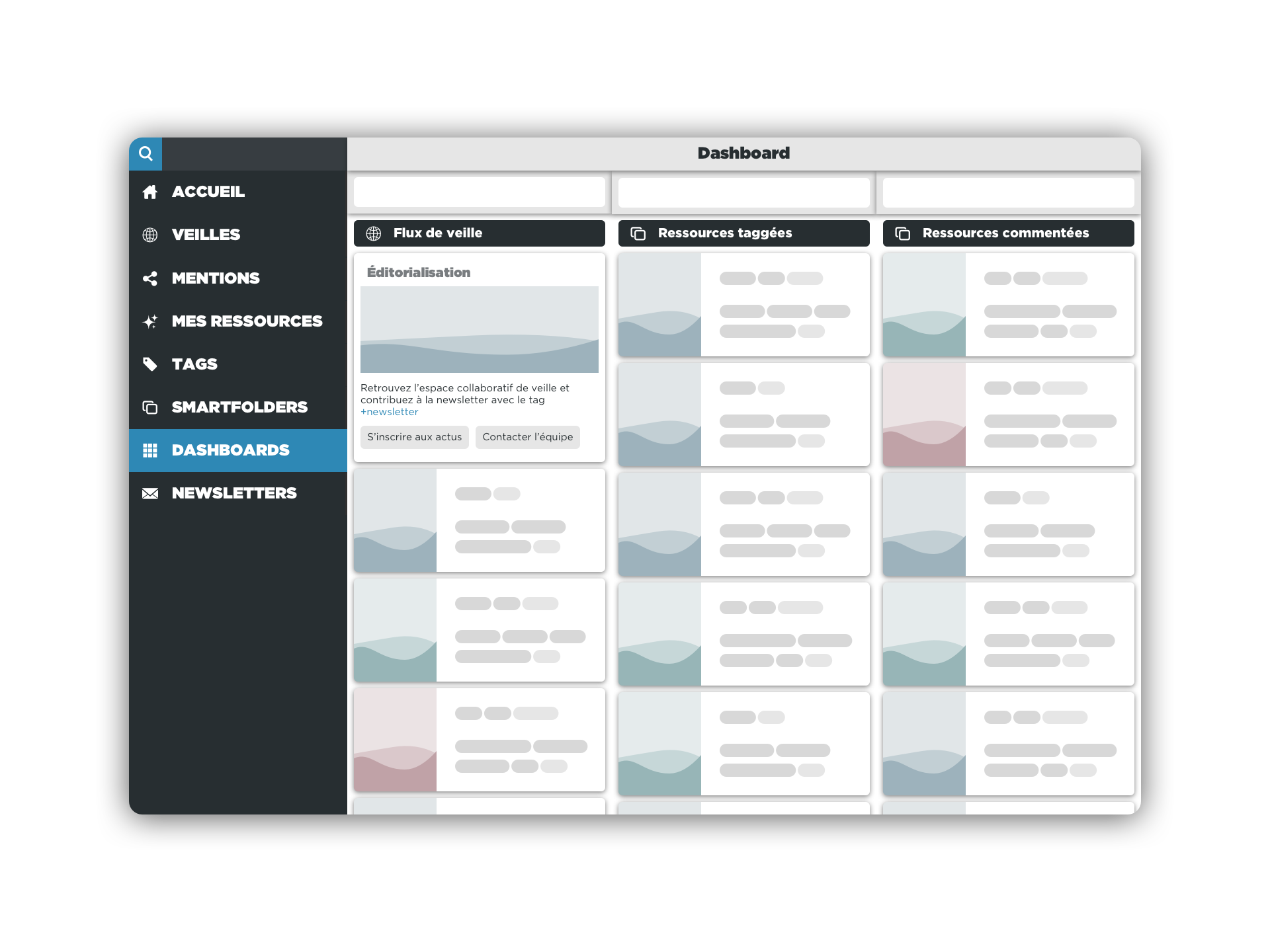Stimulate the commitment of your market intelligence community 2/3
In our previous article, we outlined the challenges associated with a collaborative intelligence project. While the benefits of such an approach may be attractive, the fact remains that engaging your contributors and mobilising them over time can be a real challenge.
To fulfil the promise of collaborative working, we suggest you focus on four key objectives:
- Demonstrate the value of your collaborative intelligence and set out its promises and benefits for each stakeholder. Yes, everyone has something to gain by helping you.
- Agree on clear rules for working together. It seems obvious, but you need to set a framework and everyone needs to be in tune with it.
- Your project forms a community: give it a raison d'être and an identity. And nurture the links within that community; it's the dynamics and multiplication of collaborative interactions that will generate the value you're looking for.
- Value your employees and support them. This is part of the necessary reciprocity. This can include helping them to set up their own collaborative intelligence projects. To which, who knows, you might even contribute.
1 - Demonstrate the value of your collaborative intelligence and share its objectives as often as necessary
Ideally, this stage should be carried out before you launch your collaborative intelligence. But it's often forgotten or underestimated, and you'll need to give regular reminders: to potential new contributors, of course, but also to those already on board who may lose sight of why they're there with you.
The lack of commitment on the part of contributors to a collaborative project is often linked to the fact that they do not perceive the value of the work carried out, in particular the benefits that they themselves can derive from it.
Think about co-defining your joint objectives.
For them, the product of your monitoring may be ‘just another newsletter among dozens of others’, or ‘just another benchmark on a hackneyed subject’. To avoid this pitfall, you'll need to show your contributors and the other stakeholders in your monitoring project that it makes sense.
Offer something in return for your contributors' commitment
Your contributors need to see the point of their involvement with you. You could, for example, start by presenting your monitoring as the essential building block of a more global project, at the level of a team, a department or even the company in some cases. In this way, the people who contribute to it will be part of a project that is valued and appreciated on a wider scale.
In addition, make sure that each of your contributors benefits from taking part in your collaborative intelligence project. The key idea is ‘give and take’. An account manager will benefit from your collaborative monitoring to deepen his knowledge of the context of his customers or of a sector of activity; a marketing manager will benefit from a broader view of the activities of his company's competitors... Everyone has something to gain from collaboration, emphasise that.
On a broader level, don't hesitate to set up meetings to share the fruits of your collaborative intelligence: monthly meetings to present the most significant information, editorial committees to select the content of a newsletter, etc.
All these moments are opportunities to encourage exchanges within your project. They are also an opportunity to highlight certain contributors (preferably volunteers) who are invited to express themselves and share their readings and understanding of the challenges of your monitoring for your organisation.
These aspects will also be covered in objectives 3 (Maintain your community) and 4 (Promote your contributors) in the next article.
Regularly check that you are meeting the needs of the people you are monitoring
It seems obvious, but monitoring is not an end in itself. What matters is that the end product meets the expectations of the audience. By setting up regular exchanges with your internal customers, you give yourself the means to refocus your monitoring if necessary, to explore new subjects and you can even inspire your readers to contribute!
It is essential to meet hearing expectations.
And don't forget to share reader feedback with all the contributors to your collaborative watch. It's important that you yourself are informed, but it's essential that this information is shared with the community producing the watch. You'll gain in relevance, efficiency and team cohesion.
Get support from your managers
Remind them that this collaborative work creates internal emulation, that the wealth and multiplication of collaborative interactions supports creativity and enriches the analysis of content; don't hesitate to regularly highlight to managers one or two key pieces of information from your monitoring, with an analysis carried out thanks to the cross-fertilisation of the contributors' expertise.
By demonstrating the benefits of monitoring to managers, they will be all the more inclined to set aside time for this activity for their staff.
What's more, experience shows that the support and involvement of managers is one of the most effective stimuli for collaboration: the communities that generate the most contributions are those in which management contributes the most.
Integrate your project with that of your company
Your intelligence is not disconnected from your company's challenges; it contributes to them, perhaps modestly, but surely.
Take the time to show that your watch is in line with your company's strategic plan or one of its variations: it probably doesn't address all the issues, but through its field of surveillance and the analyses produced, it contributes to one or more strategic areas. By opening up the objectives of your collaborative intelligence, you maximise your chances of gaining support within your company and getting your contributors on board.
2 - Remind yourself of the rules of the game for your collaborative monitoring
If you want your staff to be able to contribute effectively to your monitoring, you'll need to define a few common rules. You don't need a 1,000-page manual or a 50-step process, but you do need to specify at least :
- The scope of your monitoring: what interests you and what is off-topic;
- How do you qualify and capitalise on relevant information, whether it has been collected via your monitoring platform or comes from external studies or resources from LinkedIn, Twitter or web exploration?
- How to mobilise points of view, what mention and notification system is available;
- How to re-use information: the deliverables associated with monitoring and production processes.
A simple solution is to give your contributors some simple, practical information sheets on a specific subject: how to tag information, how to contribute to a newsletter, etc.
You can also use your collaborative intelligence tool to do this. On Curebot, for example, it's easy to insert inserts describing a watch and the associated collaborative practices. In this way, each user can edit their watch environment so that it meets their exact needs.
So, when one of your contributors uses Curebot, you can, for example, remind them of the scope of your monitoring (what you're looking for, what's off-topic, etc.), suggest a number of tags for capitalising on and remobilising information, or give them a quick reminder of how to interact with other contributors.

Another effective practice if your contributors are constrained by a lack of time is to use mobile devices to monitor your work. Let's take the Curebot platform as an example. Its interface and functionalities are the same whatever the terminal used (PC, smartphone, tablet). Why not offer your employees the chance to spend a few minutes on Curebot, while they use their mobile phones to keep up to date?
Even if they probably won't be doing a complete watch during their commute or between two meetings, they will be able to qualify and capitalise on a few articles, here and there, which will be information resources for your joint watch. This can also be an opportunity for them to take the time to comment on an article tagged by another contributor and enrich their shared understanding of the subject of your watch.
You can also use your collaborative intelligence tool to do this. On Curebot, for example, it's easy to insert inserts describing a watch and the associated collaborative practices. In this way, each user can edit their watch environment so that it meets their exact needs.
So, when one of your contributors uses Curebot, you can, for example, remind them of the scope of your monitoring (what you're looking for, what's off-topic, etc.), suggest a number of tags for capitalising on and remobilising information, or give them a quick reminder of how to interact with other contributors.
Another effective practice if your contributors are constrained by a lack of time is to use mobile devices to monitor your work. Let's take the Curebot platform as an example. Its interface and functionalities are the same whatever the terminal used (PC, smartphone, tablet). Why not offer your employees the chance to spend a few minutes on Curebot, while they use their mobile phones to keep up to date?
With your contributors and all your partners in the company, you now form a group - a community - united around a shared interest. Each of the stakeholders in this community has its own interest in participating, while enriching the project as a whole.
In our third and final article, we'll look at a few ideas and tips to help you maintain this collaborative dynamic.

